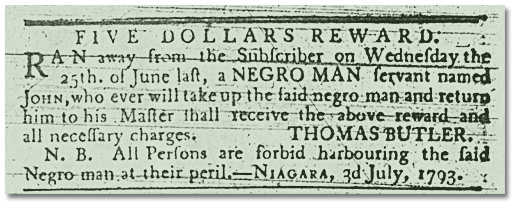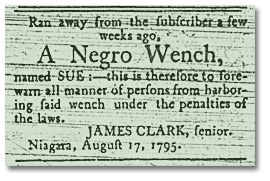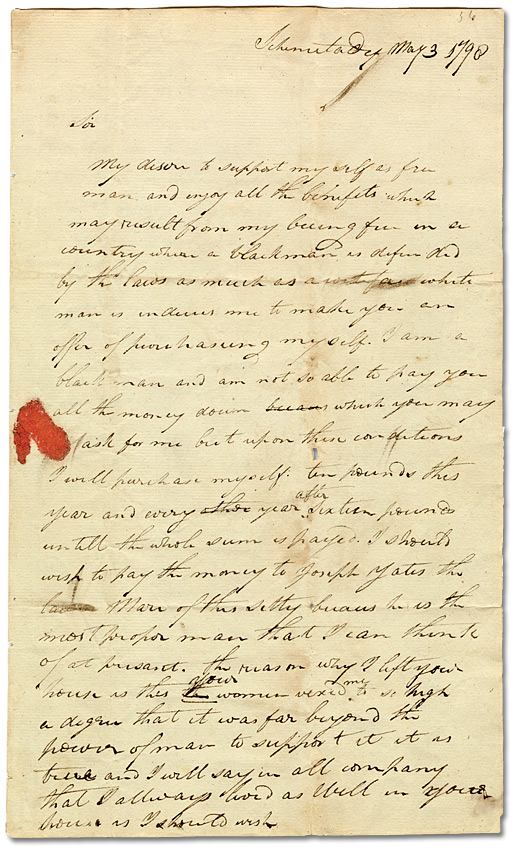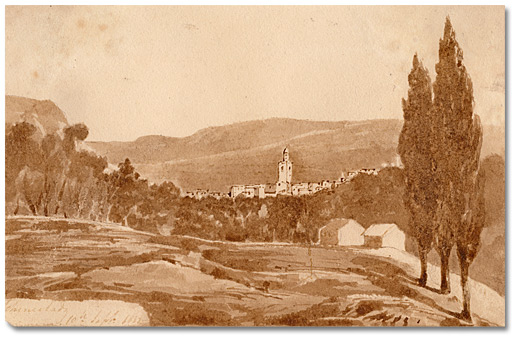
Previous | Exhibit Home | Next
Enslaved people resisted and challenged the institution of slavery. This resistance took many forms, including asserting their humanity, refusing to work, escaping bondage, or assisting freedom seekers. To dare to dream was an act of defiant resistance.
Peter Russell, the Receiver General of Upper Canada (1796-1799), and his sister Elizabeth enslaved a woman named Peggy, and her three children: Amy, Milly, and Jupiter. Elizabeth described Peggy as “insolent” and “pilfering”, referring to her resistance to service.
|
"My Slave Peggy, whom you were so good to promise to assist in getting rid of, … is now at large, being not permitted by my Sister to enter this House, and shows a disposition at Times to be very troublesome, which may perhaps compel me to commit her again to Prison. I shall be glad that you would either taker away immediately, or return to me the Bill of Sale I gave you to enable you to do so." Peter Russell to Matthew Elliott, |
![Letter from Peter Russell to Matthew Elliott [1801] Letter from Peter Russell to Matthew Elliott [1801]](../../../../images/slavery_uppercanada/resistance/Russell011.jpg)
Click to see a larger image
Letter from Peter Russell to Matthew Elliott [1801]
Archives of Ontario
F 46-0-0-2350

Upper Canada Gazette, 4 July 1793
Microfilm reel number N 31, Archives of Ontario

Upper Canada Gazette, 4 July 1793
Microfilm reel number N 31, Archives of Ontario
One example is that of Henry Lewis, who fled to Schenectady, New York from Newark (Niagara-on-the-Lake) in order to escape the ownership of William Jarvis, the provincial secretary and registrar. While there he wrote to Jarvis requesting to purchase his freedom.
|
My desired to support my self as free man and enjoy all the benefits which may result from my being free in a country whear a Blackman is defended by the laws as much as a white man is induce me to make you an offer of purchasing myself . . . . |
![Letter from Peter Russell to Matthew Elliott [1801] Painting of Hannah Jarvis hoer her two daughters](../../../../images/slavery_uppercanada/resistance/hannah_jarvis_children_520.jpg)
Click to see a larger image
Hannah Jarvis (née Peters) and her daughters. Maria Lavini and Augusta Honoria Jarvis, [ca. 1791]
James Earl
Oil on canvas
Royal Ontario Museum ©ROM,
981.79.2

Click to see a larger image
Henry Lewis letter to William Jarvis, 1798
William Jarvis Papers
Reference Code: S109 B55 PP. 56-57
Toronto Public Library (TRL)
Special Collections, Archive & Digital Collections, Baldwin Room

Click to see a larger image
Schenectady, 10th Sept. 1832
Watercolour, 108 X 168 mm
Library and Archives Canada /Dr. Nigel Davies, Gelati, Mexico (Original Source)
Acc. No. 1981-42-2 C8303471
